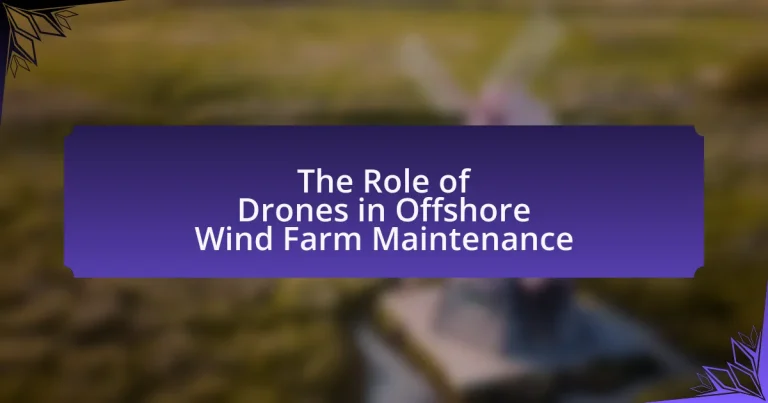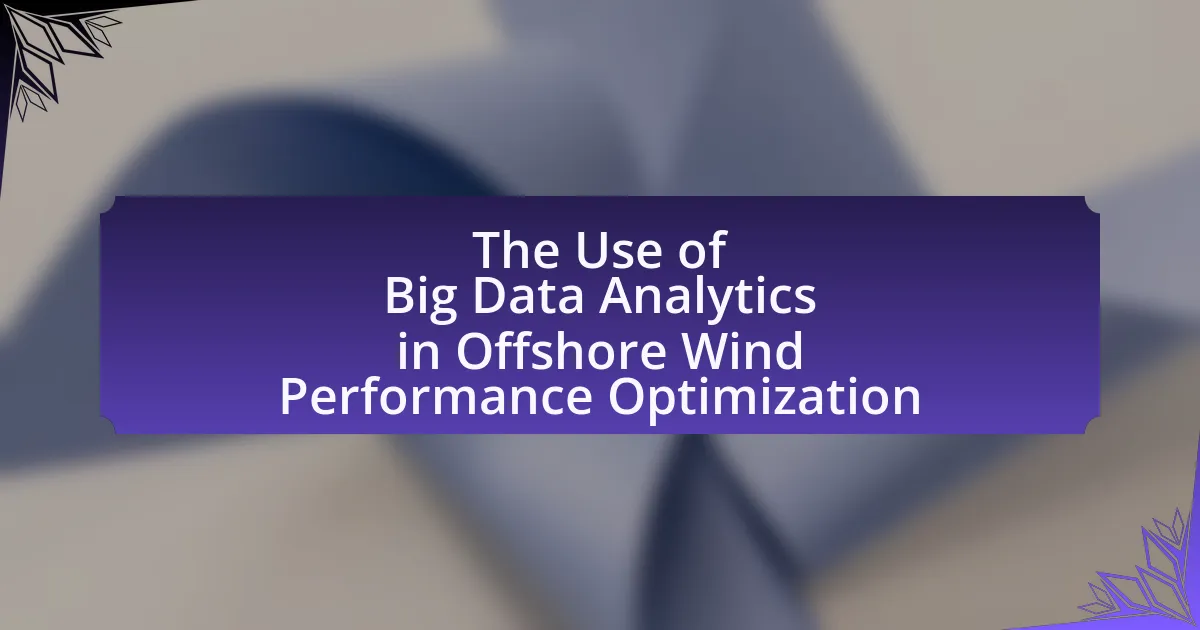Drones are increasingly vital in the maintenance of offshore wind farms, offering efficient inspection and monitoring capabilities that significantly reduce operational costs and enhance safety. Equipped with advanced technologies such as high-resolution cameras, thermal imaging, and LiDAR, drones can perform rapid assessments of turbine structures, minimizing the need for manual inspections and scaffolding. This article explores the specific tasks drones can undertake, the advantages they provide over traditional maintenance methods, and the challenges they face in offshore environments. Additionally, it discusses the regulatory considerations, technological advancements, and future trends shaping the role of drones in optimizing maintenance operations for offshore wind farms.
What is the role of drones in offshore wind farm maintenance?
Drones play a crucial role in offshore wind farm maintenance by providing efficient inspection and monitoring capabilities. They are equipped with high-resolution cameras and sensors that allow for detailed visual assessments of turbine structures, including blades and towers, without the need for scaffolding or manual inspections. This technology significantly reduces downtime and operational costs, as drones can quickly cover large areas and access hard-to-reach locations. Studies have shown that using drones for inspections can decrease maintenance costs by up to 30% and improve safety by minimizing the need for personnel to work at heights or in hazardous conditions.
How do drones contribute to the efficiency of offshore wind farm maintenance?
Drones enhance the efficiency of offshore wind farm maintenance by providing rapid, high-resolution inspections and data collection. These unmanned aerial vehicles can quickly assess the condition of turbines and infrastructure, significantly reducing the time and costs associated with traditional maintenance methods. For instance, drones equipped with thermal imaging and high-definition cameras can identify issues such as blade damage or corrosion without the need for scaffolding or cranes, which are often expensive and time-consuming to deploy. Studies have shown that using drones can decrease inspection times by up to 80%, allowing for more frequent and thorough assessments, ultimately leading to improved operational efficiency and reduced downtime for wind farms.
What specific tasks can drones perform in maintenance operations?
Drones can perform various specific tasks in maintenance operations, including visual inspections, thermal imaging, and data collection. Visual inspections allow drones to assess the condition of wind turbine components, such as blades and towers, from angles that are difficult for human inspectors to reach. Thermal imaging enables the detection of overheating components, which can indicate potential failures. Additionally, drones can collect data on structural integrity and environmental conditions, facilitating timely maintenance decisions. These capabilities enhance efficiency and safety in offshore wind farm maintenance by reducing the need for manual inspections in hazardous environments.
How do drones improve safety during maintenance activities?
Drones improve safety during maintenance activities by enabling remote inspections and reducing the need for personnel to access hazardous areas. By utilizing drones equipped with high-resolution cameras and sensors, maintenance teams can identify issues such as structural damage or equipment malfunctions from a safe distance, minimizing the risk of accidents. For instance, a study by the National Renewable Energy Laboratory found that drone inspections can reduce the time workers spend in potentially dangerous environments by up to 80%, significantly lowering the likelihood of injuries.
What are the advantages of using drones over traditional maintenance methods?
Drones offer significant advantages over traditional maintenance methods in offshore wind farm maintenance by enhancing efficiency, safety, and data collection capabilities. Drones can access hard-to-reach areas quickly and safely, reducing the need for scaffolding or cranes, which minimizes downtime and labor costs. For instance, a study by the National Renewable Energy Laboratory found that using drones can reduce inspection times by up to 80% compared to conventional methods. Additionally, drones equipped with high-resolution cameras and sensors provide detailed visual and thermal data, enabling proactive maintenance and reducing the risk of equipment failure. This combination of speed, safety, and advanced data collection makes drones a superior choice for maintaining offshore wind farms.
How do drones reduce operational costs in offshore wind farm maintenance?
Drones reduce operational costs in offshore wind farm maintenance by enabling efficient inspections and data collection without the need for costly scaffolding or vessels. Their ability to quickly assess the condition of turbines and infrastructure minimizes downtime and labor expenses. For instance, a study by the National Renewable Energy Laboratory found that drone inspections can reduce inspection costs by up to 50% compared to traditional methods. Additionally, drones can cover large areas in a fraction of the time, leading to faster maintenance responses and reduced operational disruptions.
What impact do drones have on maintenance timeframes?
Drones significantly reduce maintenance timeframes in offshore wind farms by enabling rapid inspections and assessments. Traditional maintenance methods often involve lengthy processes, including scaffolding or vessel mobilization, which can take days or weeks. In contrast, drones can quickly survey large areas and identify issues in real-time, often completing inspections in a fraction of the time, sometimes within hours. For instance, a study by the National Renewable Energy Laboratory found that drone inspections can reduce the time required for visual assessments by up to 80%, leading to faster decision-making and maintenance actions. This efficiency not only minimizes downtime but also enhances the overall operational effectiveness of offshore wind farms.
What technologies enable drones to be effective in offshore wind farm maintenance?
Drones in offshore wind farm maintenance are enabled by technologies such as high-resolution cameras, LiDAR, thermal imaging, and GPS. High-resolution cameras allow for detailed visual inspections of turbine blades and structures, identifying wear or damage. LiDAR technology provides precise measurements of the turbine’s physical condition and surrounding environment, enhancing data accuracy. Thermal imaging detects heat anomalies, indicating potential electrical issues or overheating components. GPS technology ensures accurate navigation and positioning, crucial for operating in challenging offshore environments. These technologies collectively enhance the efficiency and effectiveness of maintenance operations, reducing downtime and improving safety.
What types of drones are commonly used in offshore wind farm maintenance?
The types of drones commonly used in offshore wind farm maintenance include fixed-wing drones, multirotor drones, and hybrid drones. Fixed-wing drones are utilized for long-range inspections and can cover large areas efficiently, making them suitable for monitoring multiple turbines in a single flight. Multirotor drones are preferred for detailed inspections due to their ability to hover and maneuver around structures, allowing for close-up assessments of turbine blades and other components. Hybrid drones combine the advantages of both fixed-wing and multirotor designs, offering versatility in various operational scenarios. These drones enhance maintenance efficiency by providing high-resolution imagery and data collection capabilities, which are essential for timely maintenance decisions.
How do fixed-wing drones differ from multi-rotor drones in this context?
Fixed-wing drones differ from multi-rotor drones in offshore wind farm maintenance primarily in their flight capabilities and operational efficiency. Fixed-wing drones are designed for longer flight durations and can cover larger areas due to their aerodynamic structure, making them suitable for extensive inspections of wind farms. In contrast, multi-rotor drones excel in vertical takeoff and landing, allowing for precise maneuverability and detailed inspections of specific turbine components. This distinction is crucial in offshore wind farm maintenance, where the ability to efficiently survey vast areas versus conducting detailed inspections can significantly impact operational effectiveness and cost efficiency.
What are the key features of drones that enhance their maintenance capabilities?
The key features of drones that enhance their maintenance capabilities include high-resolution imaging, real-time data transmission, and autonomous flight capabilities. High-resolution imaging allows for detailed inspections of wind turbine components, enabling early detection of wear and damage. Real-time data transmission facilitates immediate analysis and decision-making, improving response times for maintenance needs. Autonomous flight capabilities enable drones to operate in challenging environments without direct human control, increasing efficiency and safety during inspections. These features collectively contribute to more effective and timely maintenance of offshore wind farms.
How do drones utilize data collection and analysis in maintenance tasks?
Drones utilize data collection and analysis in maintenance tasks by capturing high-resolution images and videos, which are then processed to identify structural issues and assess the condition of wind turbine components. This technology enables real-time monitoring and detailed inspections, significantly reducing the time and cost associated with traditional maintenance methods. For instance, a study by the National Renewable Energy Laboratory found that drone inspections can reduce inspection times by up to 80% compared to manual methods, while also increasing the accuracy of damage detection.
What types of sensors are integrated into drones for maintenance inspections?
Drones for maintenance inspections are integrated with various types of sensors, including visual cameras, thermal imaging cameras, LiDAR sensors, ultrasonic sensors, and GPS. Visual cameras capture high-resolution images for visual inspections, while thermal imaging cameras detect heat anomalies, indicating potential issues like overheating components. LiDAR sensors provide precise 3D mapping and structural analysis, essential for assessing the integrity of wind turbine structures. Ultrasonic sensors are used for detecting flaws in materials, and GPS ensures accurate positioning during inspections. These sensor integrations enhance the efficiency and effectiveness of maintenance inspections in offshore wind farms.
How is the data collected by drones used to inform maintenance decisions?
Data collected by drones is utilized to inform maintenance decisions by providing real-time insights into the condition of offshore wind farm components. This data includes high-resolution images and thermal readings that help identify wear, corrosion, or other issues that may require maintenance. For instance, a study by the National Renewable Energy Laboratory found that drone inspections can detect anomalies with up to 95% accuracy, enabling timely interventions and reducing downtime. By analyzing this data, maintenance teams can prioritize repairs based on urgency and potential impact, ultimately enhancing operational efficiency and safety in offshore wind farm management.
What challenges do drones face in offshore wind farm maintenance?
Drones face several challenges in offshore wind farm maintenance, primarily due to harsh environmental conditions. These challenges include strong winds, saltwater corrosion, limited battery life, and regulatory restrictions. Strong winds can affect drone stability and control, making it difficult to conduct inspections or repairs effectively. Saltwater exposure can lead to rapid wear and tear on drone components, necessitating frequent maintenance or replacement. Limited battery life restricts the operational range and duration of drone missions, which is critical in expansive offshore environments. Additionally, regulatory restrictions can complicate flight operations, requiring compliance with specific guidelines that may limit drone usage in certain areas.
What are the regulatory considerations for using drones in offshore environments?
Regulatory considerations for using drones in offshore environments include compliance with aviation regulations, safety protocols, and environmental protections. Specifically, operators must adhere to the Federal Aviation Administration (FAA) regulations in the United States, which govern drone flight operations, including altitude restrictions and no-fly zones. Additionally, operators must ensure that drones do not interfere with manned aircraft and must obtain necessary permits for operations over water. Environmental regulations, such as the National Environmental Policy Act (NEPA), may also apply, requiring assessments to minimize impacts on marine life and habitats. Compliance with these regulations is essential to ensure safe and responsible drone operations in offshore settings.
How do weather conditions affect drone operations in offshore wind farms?
Weather conditions significantly impact drone operations in offshore wind farms by influencing visibility, wind speed, and precipitation levels. High winds can limit drone stability and control, making it difficult to conduct inspections or maintenance tasks effectively. For instance, drones typically have operational wind speed limits ranging from 15 to 25 knots; exceeding these limits can lead to crashes or loss of control. Additionally, poor visibility due to fog or rain can hinder the drone’s ability to navigate and capture clear images, which are essential for monitoring turbine conditions. Studies have shown that adverse weather can reduce operational efficiency by up to 30%, highlighting the importance of weather assessments before drone deployment in offshore environments.
What technical limitations do drones encounter during maintenance tasks?
Drones encounter several technical limitations during maintenance tasks, including battery life constraints, payload capacity restrictions, and environmental sensitivity. Battery life typically limits operational time to 20-30 minutes, which can hinder extensive inspections or repairs. Payload capacity restricts the types of tools and equipment that can be carried, often necessitating multiple trips for comprehensive maintenance. Additionally, drones are sensitive to adverse weather conditions, such as high winds and rain, which can impede their ability to operate safely and effectively. These limitations can significantly affect the efficiency and reliability of drone-assisted maintenance in offshore wind farms.
How can the challenges of drone usage in offshore wind farm maintenance be mitigated?
The challenges of drone usage in offshore wind farm maintenance can be mitigated by implementing advanced training programs for operators and enhancing drone technology. Training programs ensure that operators are skilled in navigating complex offshore environments and can effectively manage adverse weather conditions, which are common in such settings. Additionally, investing in robust drone technology, such as improved battery life and weather-resistant designs, allows drones to operate more reliably in harsh conditions. For instance, drones equipped with thermal imaging and LiDAR can perform inspections more efficiently, reducing the need for manual checks and minimizing downtime. These strategies collectively enhance operational efficiency and safety in offshore wind farm maintenance.
What best practices can be implemented for effective drone operations?
Effective drone operations can be achieved by implementing best practices such as thorough pre-flight planning, adherence to safety regulations, and regular maintenance checks. Pre-flight planning involves assessing weather conditions, flight paths, and potential obstacles to ensure safe and efficient operations. Adhering to safety regulations, including compliance with local aviation laws and guidelines from organizations like the Federal Aviation Administration (FAA), minimizes risks associated with drone flights. Regular maintenance checks, including battery inspections and software updates, enhance the reliability and performance of drones, which is crucial for tasks in offshore wind farm maintenance. These practices collectively contribute to the successful and safe deployment of drones in complex environments.
How can advancements in technology improve drone performance in this field?
Advancements in technology can significantly improve drone performance in offshore wind farm maintenance by enhancing their navigation, battery life, and data collection capabilities. For instance, the integration of AI and machine learning algorithms allows drones to autonomously navigate complex environments, avoiding obstacles and optimizing flight paths. Additionally, advancements in battery technology, such as lithium-sulfur batteries, can extend flight times, enabling drones to cover larger areas without needing to recharge frequently. Furthermore, high-resolution cameras and advanced sensors improve data collection, allowing for more accurate inspections of wind turbine components. These technological improvements lead to increased efficiency and reliability in maintenance operations, ultimately reducing downtime and operational costs for offshore wind farms.
What are the future trends for drones in offshore wind farm maintenance?
Future trends for drones in offshore wind farm maintenance include increased automation, enhanced data analytics capabilities, and improved battery technology. Automation will allow drones to perform routine inspections and maintenance tasks autonomously, reducing the need for human intervention and increasing efficiency. Enhanced data analytics will enable drones to collect and analyze vast amounts of data in real-time, facilitating predictive maintenance and reducing downtime. Improved battery technology will extend flight times and operational range, allowing drones to cover larger areas of wind farms without needing to recharge frequently. These advancements are supported by ongoing research and development in drone technology, which aims to optimize maintenance processes and reduce operational costs in the offshore wind sector.
How might emerging technologies shape the role of drones in maintenance?
Emerging technologies will significantly enhance the role of drones in maintenance by enabling advanced data collection, real-time monitoring, and autonomous operations. For instance, the integration of artificial intelligence allows drones to analyze structural integrity and detect anomalies in offshore wind farms more efficiently than traditional methods. Additionally, the use of high-resolution imaging and LiDAR technology improves the accuracy of inspections, reducing downtime and maintenance costs. According to a study by the National Renewable Energy Laboratory, drones equipped with these technologies can complete inspections in a fraction of the time compared to manual methods, demonstrating their effectiveness in optimizing maintenance processes.
What potential developments could enhance drone capabilities in offshore environments?
Advancements in battery technology could significantly enhance drone capabilities in offshore environments. Improved energy density and efficiency would allow drones to operate longer distances and durations, which is crucial for accessing remote offshore wind farms. For instance, the development of solid-state batteries has shown potential to increase energy capacity while reducing weight, enabling drones to carry more equipment and perform complex inspections without frequent recharging. Additionally, advancements in autonomous navigation systems, such as enhanced GPS and obstacle detection technologies, would improve operational safety and reliability in challenging offshore conditions, thereby increasing the effectiveness of drone missions in wind farm maintenance.
What practical tips should operators consider when using drones for offshore wind farm maintenance?
Operators should consider several practical tips when using drones for offshore wind farm maintenance. First, they should ensure compliance with local regulations and airspace restrictions to avoid legal issues. Second, operators must conduct thorough pre-flight checks to verify the drone’s functionality and battery life, as equipment failure can lead to accidents or data loss. Third, utilizing drones equipped with high-resolution cameras and thermal imaging can enhance inspection capabilities, allowing for the identification of potential issues such as corrosion or overheating. Additionally, operators should implement a robust data management system to analyze and store the collected data efficiently, facilitating timely maintenance decisions. Finally, training personnel in drone operation and maintenance is crucial to maximize safety and operational efficiency.




